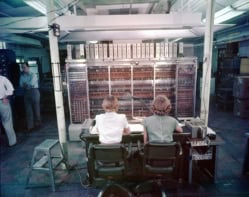Can the growth of solid-state physics be likened to a Star Wars plot? Robert P Crease agrees that it can

In a daring image at the beginning of Solid State Insurrection: How the Science of Substance Made American Physics Matter, science historian Joseph D Martin compares the rise of solid-state physics to the plot of the original Star Wars movie. Both, he points out, involve “a ragtag band of misfits, many of whom are adept at manipulating a force pervading everyday matter, who ally to mount an insurrection against the established order and help destroy a giant, partially built beam machine”.
At first the image seems over the top, the hyped image of a popularizer. But what follows over the next thoroughly documented 200 pages is a dramatic story, by a skilled historian, of just that.
Martin’s tale begins in the 1940s, with Bell Labs’ characterization in 1946 of “solid-state physics” as a research area, and the American Physical Society’s creation of a division of solid-state physics the following year. These steps gave the field institutional recognition. Throughout the next few decades however it struggled, lacking not only prestige but also solidarity, so to speak. While nuclear and particle physics were more or less unified, their solid-state sibling was “balkanized” into subgroups, “analogous to a disorganized system beginning to self-organize”, as Martin puts it.
For the next few decades, solid-state physics continued to lack status and voice, and was famously dismissed by Murray Gell-Mann as “squalid state physics” and by Wolfgang Pauli as Schmutzphysik (literally, dirty physics). In the 1960s, it acquired its first big user facility, the National Magnet Laboratory at the Massachusetts Institute of Technology. Sceptics began to challenge contentions by particle physicists that their field was the frontier – not only the most fundamental branch of physics but also the one responsible for applications and spinoffs. Resistance leaders included Alvin Weinberg, director of Oak Ridge National Laboratory, who in the 1960s challenged particle physicists about the meaning of “fundamental physics” and Bell Labs theorist Philip Anderson with his 1972 Science article “More is different”.
In the 1970s solid-state physics began to mature as a discipline, but continued to suffer an identity crisis from its interdisciplinary nature and inevitable unfavourable comparisons with its wealthier, prominent and more unified sibling – particle physics. Martin is engrossing in tracing the sometimes bumpy reframing during the years that followed, of solid-state physics morphing into materials science (a more interdisciplinary field), then into condensed-matter physics – a European concept that included liquid matter.
Fighting the death star
While all this was going on, US high-energy physicists continued to monopolize the discipline’s prestige, funding and facilities. In 1982 they hatched a plan for their biggest facility yet: a giant beam machine. The Superconducting Super Collider (SSC), was to be built in Texas, targeting discovery of the Higgs particle or whatever other key physics phenomenon was behind the secret of mass. High-energy physics seemed to be not only the frontier but entering an era of “Megascience”, with projects of ever bigger scale, collaborations and funding.
But directors of existing high-energy labs feared the SSC would divert badly needed money from their projects; materials scientists feared that funding for their fields would dry up. In 1986, to head off growing opposition, the director of the Office of Energy Research at the Department of Energy, Alvin Trivelpiece, devised a plan whose impact, in my opinion, is insufficiently recognized by Martin.
Trivelpiece decided to award each of four national laboratories a large facility. Three – the Advanced Light Source at Berkeley, the Advanced Photon Source at Argonne, and the Advanced Neutron Source at Oak Ridge – would serve materials scientists, while the fourth – the Relativistic Heavy Ion Collider – exploited infrastructure that Brookhaven National Laboratory had previously built for an accelerator that had been axed to support the SSC.
The SSC’s promoters, however, made two errors. First, they underestimated its cost – partly to kill Brookhaven’s accelerator, partly from technical over-optimism and partly from mismanagement. Second, they misjudged the impact of materials scientists’ newfound strength. In Martin’s words, the SSC crystallized “the boiling over of tensions that had strained the American physics community for half a century”.
The ensuing controversies in scientific literature and the halls of Congress finally exposed the weak underpinnings of claims that physics at high energies was the font of applications and spinoffs and also the field’s true frontier. The notion of a single intellectual frontier – a “reductionist worldview,” Martin says, that amounted to “pure-science fundamentalism” – was challenged practically by the excitement surrounding such endeavours as the Human Genome Project. It was also challenged theoretically by serious philosophical examination of Anderson’s point that “more is different”.

The X-reality files: searching for the truth about the world
Anderson’s view was that the behaviour of metals could not be understood simply by adding particles together; instead it had to be approached with unique sets of concepts and tools. When the SSC – overbudget and lacking support across the full physics community – was terminated by the US Congress in 1993, the four components of the Trivelpiece plan were under way. Condensed-matter physics was thereby not only “left standing”, as Martin puts it, after the US Congress’s vision of advanced physics was shot down, but well equipped to advance. The material – in the sense of facilities – for materials science was solidly in place.
The critical point
The transformation of solid-state physics into condensed-matter physics, and its support by a wide variety of facilities in the wake of the destruction of the Death Star, is part of a bigger story that involves the morphing of physics into a different, more pluralistic kind of science during the past three decades in particular. Unlike Star Wars, though, this tale doesn’t take place a long time ago and far, far away. Instead, it is still unfolding right in front of us. In a future column I’ll provide an illustration.



